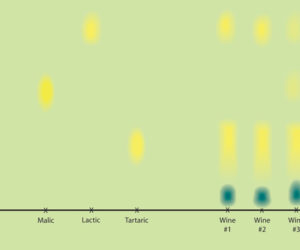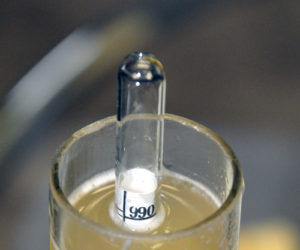Q
In your great book The WineMaker’s Answer Book you say, “Small scale winemakers are probably safe adding 3 grams per gallon (4 L) of bentonite to their wines.” Are you referring to sodium bentonite or to calcium bentonite? Would you please explain the differences in the two bentonite options relating to dosages and effectiveness?
Richard Parry
Ignacio, Colorado
A
Wine, as I’ve often written, is a complex chimerical soup. Wine naturally contains lots of different amino acids and some of those amino acids are in long-chain form and actually are proteins. Because proteins are pretty big molecules (as molecules go), they sometimes are so big they can’t be dissolved in the wine as a liquid anymore and are actually visible to the naked eye. If your wine has enough of these proteins your wine might be so cloudy as to have a visible “protein haze.” Now, amino acids and proteins in wine aren’t dangerous or bad for you, but they might keep your wine from being the sparklingly clear liquid you’d like it to be. This is where fining (or treating) with bentonite comes in.
Bentonite is a naturally-occurring clay that has been used in winemaking for centuries. It comes in powdered form and is rehydrated in water or wine before being added as a slurry to wine. The clay particles swell up in the liquid and adsorb the positively-charged protein molecules. Then the big protein-bentonite agglomeration gets so big and heavy that it falls (or flocculates) to the bottom of the vessel, hopefully leaving clear wine above a layer of sediment. The winemaker is then able to siphon off, or rack, the clean wine from the lees.
Since bentonite can also adsorb some aroma and flavor compounds, it’s important to add the minimum amount of bentonite needed to do the job. If you are just looking for immediate visual clarity, just add the amount that gives you that result. If, however, you want to make sure that the wine is “heat stable” and will not throw a protein haze with increased time or temperature, you may need to add a little more than would make it visually clear. In the commercial wine lab you’ll typically add increasing amounts of bentonite slurry to a sample until, when filtered and “cooked” in an incubator (say at 80 °F/27 °C for 24 hours) no protein haze is visually apparent. Then the indicated amount is added in the cellar.
Now to get to your more detailed question — is sodium or calcium bentonite preferred and what are the differences between the two additives? Since bentonite is a naturally-occurring clay that is mined from deposits in the earth (Wyoming, for instance, is a famous source of a very pure vein) other minerals and ions can come “attached” to it. Most folks I talk to say that sodium bentonite and calcium bentonite are interchangeable in winemaking. In fact, often a bentonite product you might buy off the shelf won’t even specify if it’s “calcium” or “sodium” bentonite, it makes that little of a difference.
Some people say they prefer calcium bentonite because it forms more compact lees, but I also know if you have too much calcium in your wine you could form calcium tartrate crystals instability, which can’t be fined out by seeding with potassium bitartrate. I’ve also read that sodium bentonite can leach small amounts of sodium ions into wine and indeed can cause an increase in a few mg/L . . . but at the end of the day wine will always be a “low sodium” beverage and not enough of a nutritional concern. The research I’ve done shows the dosage rates and application are similar enough to not warrant special instructions. As with any additive, the most important thing is that bench trials be done so you can use the minimum bentonite to perform the task you want done. This is to save money, of course, but most importantly to save you from unnecessarily stripping aromas, flavors and anything else from your wine if too much is added. The maximum dose before aroma stripping becomes obvious is 1 g/L in whites, and about half that amount in reds.
Q
I use a refractometer to measure the progress of my wines rather than a hydrometer. I know the alcohol throws off the reading as soon as fermentation starts, but it seems to me that if you knew the initial gravity and the refractometer measurement, you would have enough information to correct the refractometer measurement and work out the actual sugar content. Do you know of such an equation for this?
Scott Lair
Laramie, Wyoming
A
That is a great question. The “simple” answer is that no, hydrometry and refractometry are not interchangeable and that you shouldn’t try to use a refractometer during active fermentation. Refractometry relies on measuring how a ray of light will bend (refract) through liquids of different densities to be read out on a scale. Hydrometry relies directly on density of a solution itself and accounts for a density change as the sugar disappears and alcohol (alcohol is less dense than water) is generated.
When I was a winemaking student at UC-Davis we were taught that refractometers are best used for unfermented juice as an initial Brix reading and that once fermentation started, hydrometers were the best tool to monitor fermentations. This is because alcohol and carbon dioxide bubbles will both interfere with how the ray of light passes through the refractometer and are difficult to control for. However, as you bring up, there should be a way to calculate the effect of the alcohol to arrive at a “corrected” sugar level.
Some people have attempted to do so. There is an interesting post I found on www.valleyvintner.com, the website of The Valley Vintner, a respected winemaking supply shop based in Livermore, California. They did just what you are proposing and used a refractometer alongside a hydrometer on a test fermentation. Then they tried to “calculate out” the increasing alcohol level (and decreasing density) to create a relative Brix (or specific gravity) using a refractometer. The math is complicated but to make it a little simpler the good folks at The Valley Vintner created a spreadsheet that you can use to correlate a refractometer reading to the true sugar level. You can find that here: http://valleyvintner.com/Refrac_Hydro/Refract_Hydro.htm
In all of the wineries where I work, we either use hydrometers or a digital densitometer like the Anton Paar DM35 handheld model to monitor fermentations. Hydrometers, albeit a little old fashioned, seem to work well to monitor the disappearance of sugar over time and are relatively inexpensive. They are, however, very breakable and the readings have to be corrected for any temperature variation from 68 °F (20 °C). The Anton Paar gadget is a couple thousand dollars but if you’re doing hundreds of samples during the morning “Brix run” for weeks on end during harvest, they are worth their weight in gold.
So, should you try to use a refractometer to monitor your fermentations? It’s up to you. You could be like the folks at The Valley Vintner and give it a try to see how well it correlates with your hydrometer measurements. The carbon dioxide bubbles are hard to correct for on a refractometer and the Valley Vintner’s method doesn’t seem to try to correct for them. If you are using a hydrometer, be aware that high solids in your juice sample, as well as carbon dioxide bubbles that might adhere to the hydrometer stem may cause it to read “lighter” (float higher) than the sample actually is. It just seems like no method is perfect.
I will say this, however. In my opinion, it’s OK if Brix during fermentation is not a 100% accurate number. The most important thing you are monitoring is the progress of the fermentation, not necessarily the absolute sugar number. That may sound a little strange, but for example, I’m much more concerned over whether my fermentation is active and my Brix has dropped 1.7 degrees in 24 hours rather than is it exactly 19.4 Brix right at this moment. For me, it’s about monitoring the health and completion of a fermentation rather than an exact number at any given time. Once your hydrometer readings bottom out at -1.5 for three days in a row you know you’re probably pretty “dry” and it’s time to start using Clinitest tablets to test for minute amounts of reducing sugar anyway. In commercial wineries, when we get to this point, we send a sample of the new wine to the lab for a Glucose + Fructose test to see how dry we really are. Most wineries consider anything under 0.15% (1.5 g/L) sugar to be “dry.”
Q
I make a Chilean Malbec every year and this year I aged it in a barrel for 16 months and over that time I racked every two months. Now it’s in a 14-gallon (54-L) demijohn to smooth out the taste a little bit before bottling. Before I put it in the demijohn I tasted it — while the flavor is good it really has to breathe for a couple of hours before it mellows out. I’m not big on putting anything in my wine, but if there is a recommendation that will smooth it out I would certainly consider it.
Robert J Carbone
Summit, New Jersey
A
Even my “purist” winemaking friends usually aren’t opposed to doing a little egg white fining when it comes to smoothing out the rough edges on their big reds. It’s an ancient and very traditional winemaking technique that is affordable and very easy to do. I cover the topic on page 199 in The Winemaker’s Answer Book, but in a nutshell (or eggshell) the process is roughly this:
1. Lightly beat an egg white or two with a few tablespoons of water and a pinch of salt.
2. Gently stir this solution into your red wine (typically a safe addition rate to start with is 1 egg white per 59-gallon/223-L barrel, assuming an egg white yields around 28 mL of egg white. You can scale it up or down to your own batch size from there).
3. Let settle for a week, then rack your wine off of the sediment that forms.
Now if you’ve been reading my articles and books you know I always advocate bench trials with any kind of addition. This is to be able to tell what is the minimum amount of addition that will yield the desired effect. In your case, since you have such a big, tannic wine, it’s possible you’ll want to add a little more egg white-to-wine than the ration I referenced in Step 2. Feel free to experiment. I hope that it’ll “take the edge off” of your big tannic wine and make it a little smoother to your palate.






